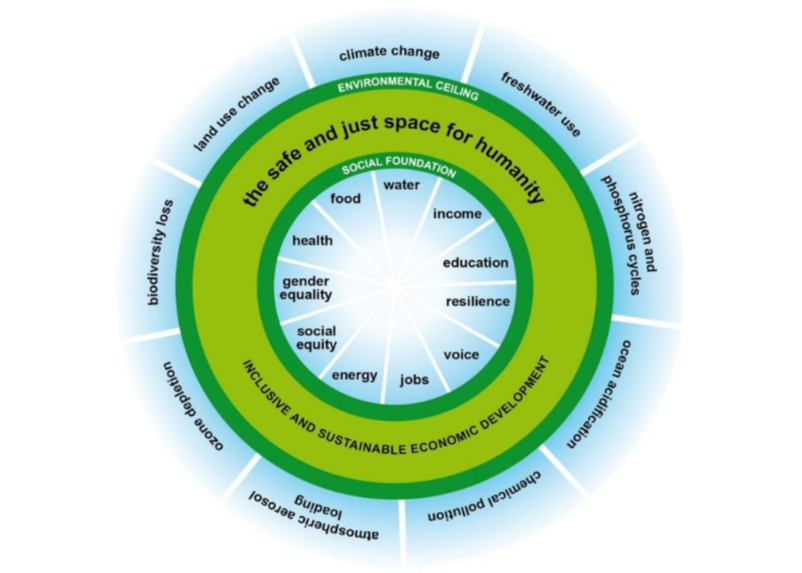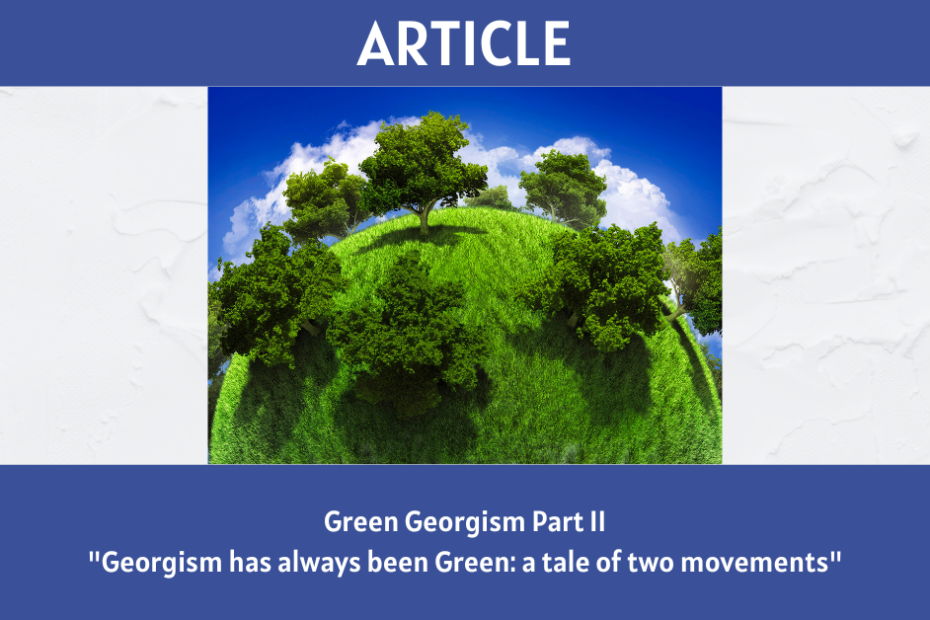Building upon the foundation laid in our first blog, “Green Georgism: Environmentalism through the eyes of Resource Justice,” our second piece delves deeper into the connections between Henry George’s ideas and key perspectives from the past century of environmentalism. This blog explores how Georgism dovetails with key aspects of environmentalism, and provides useful insights into the sustainable and equitable management of natural resources. By examining the broader definition of land as encompassing all natural materials, forces, and opportunities, we align George’s vision with modern environmental concerns, addressing issues such as urban sprawl, wealth inequality, and the preservation of natural capital.
Historical Allies
Prominent Georgists have continually supported green policies over the past 150 years, influencing conservation of national parks by both Roosevelt presidents, taxes on land and mineral extraction in Britain’s People’s Budget, and the leasing and collection of royalties from coal, gas, and petroleum extraction. Often these policies spoke of conserving resources in explicitly Georgist terms, with Henry George Jr. explaining that the People’s Budget would reassert the people’s control over natural resources, and the Democratic platform under George Creel declaring that “our natural resources which have hereto escaped their just proportion of taxation, must be recognized as natural sources of state revenue.” Herbert Quick, a Georgist who coined the concept of The Good Ship Earth, predicted climate change and resource depletion’s impact on mass migrations and called for global organizations to respond.
More recently, Georgist economists have argued the environmental benefits of land value taxes (LVT) to tackle urban sprawl, preserve natural capital, and fight climate change. Georgists have consistently promoted the idea that polluting externalities should face ecotaxes (like a carbon tax), royalties or severance taxes for depletable resources, and leasing or taxing of non-depletable resources like land. These policies continued to have strong support across the environmental movement’s various phases.
Herman Daly and Natural Capital
Herman Daly was a prominent ecological economist who championed sustainable development through his career at the World Bank. He argued that manufactured capital was distinct from natural capital, where the latter refers to the stock of natural resources which generate a flow of ecosystem services over time. This is perfectly parallel to Georgist conceptions of land or nature as being meaningfully different from capital which is produced through human effort. Daly expands on this by drawing a distinction between our treatment of renewable natural resources, such as wood and fisheries, and non-renewables like fossil fuels and mineral deposits. Both Daly and Georgists critique mainstream neoclassical economics for lumping nature in with capital in two-factor models such as the Cobb-Douglas production function, arguing that this undervalues the role of nature, which incorrectly assumes that it can easily be substituted for capital, and counts the unsustainable physical drawdown of natural resources as income. Sustainable development, according to Daly, requires that the stock of natural resources be maintained at a constant level overall: “If we continue to ignore natural capital, we may push welfare down while we think we are building it up.”
Daly explains that when human populations were small and undeveloped, human prosperity was limited by access to manufactured capital. Conversely, explosive growth of both human populations and the availability of manufactured capital has now made access to nature the more important constraint. Henry George’s unbounded savannah likewise explains how small populations enjoy unlimited access to nature, but that as growing populations cluster into cities, competition over limited locations will drive land values upwards. Both Daly and Georgist economists emphasize that humanity must economize on the limiting factor in production, which in the modern world is land and natural resources.
Daly recommended a cap-auction-trade scheme for natural resources and waste sinks, and advised governments to reduce income taxes and substitute them with taxes on the depletion of natural resources. Ultimately, he came to call himself “sort of a Georgist” and endorsed a split-rate tax that would heavily tax land compared to buildings, identical to the tax shift policies that we investigate here at Resource Justice.
Elinor Ostrom & The Commons
Elinor Ostrom’s work on governance of the commons has made significant contributions to our understanding of community-driven approaches to management of collective resources. The concept of the commons refers to resources owned in common and accessible to all members of society. Ostrom’s research challenged the conventional notion of the tragedy of the commons, which claimed that shared resources would inevitably be depleted due to over-consumption by selfish individuals. Instead, Ostrom demonstrated that communities can successfully govern common resources through principles of collective decision-making, well-defined boundaries, and effective social enforcement mechanisms.
While Ostrom’s work mainly focuses on the management of commons at a local or community level, there are challenges in applying these principles to commons operating at a larger geographic scale, such as the global carbon sink. It is very difficult for local communities to exert sufficient social pressure to reduce global emissions to sustainable levels, with both individuals and nations having strong incentives to defect and consume more than their fair share. In such cases, Georgist perspectives build on Ostrom’s principles and offer actionable solutions to the unmanaged commons by creating mechanisms for natural resources to be owned in common. For example, carbon pricing treats the atmosphere as a global commons, allowing communities to charge a fee to those who consume part of the carbon sink.
Kate Raworth & Doughnut Economics
The concept of the Doughnut, as introduced by Kate Raworth, offers a unique framework for understanding the relationship between human well-being and planetary boundaries. The Doughnut consists of two concentric rings. The interior ring represents the social foundation indicating the minimum resource input required to meet the basic needs of humanity, below which people will be in a state of critical deprivation. Our RJ mission statement recognizes that we do need to efficiently use natural resources to enhance human wellbeing while sharing the bounty in ways which help lift living communities out of poverty.
On the other hand, the outer ring of the Doughnut represents the ecological ceiling, symbolizing the maximum use of resources to sustainably serve future generations. Consuming resources beyond this threshold will result in critical degradation of our home planet. We likewise mirror this principle at RJ by recognizing that policymakers must be stewards of the natural world, pursuing resource use which is sustainable and in the long term interest of both current and future generations.

Raworth advocates for economic systems that are distributive by design, meaning that they must have built-in mechanisms for sharing the benefits of social progress. She specifically identifies the need to redistribute the wealth that comes from ownership of land. Georgism offers an ideal solution here, as land value taxes automatically capture the value of social progress which continually embeds into rising land values. Wide distribution of these rents through social services or a universal basic income offer a perpetual mechanism for sharing land rents with all members of society, ensuring that rising economic tides necessarily lift all boats. Raworth specifically invokes Henry George’s LVT as a way to treat land as a communal resource and calls for tax shifts which replace taxes on workers with charges on non-renewable natural resources.
Conclusion
We can therefore observe many clear points of alignment between environmentalism and the Georgist worldview. Both focus our attention on the natural world and call for us to economize on our use of these most precious resources. Herman Daly’s conclusions fit right into the Georgist playbook, such as his call for cap-auction-trade systems and a shifting of the tax base onto land values. Likewise, Georgist perspectives offer effective policy tools for the management of the global commons, witnessed in the desperate need for countries around the world to adopt carbon pricing. Capturing and sharing of land values can help to achieve Kate Raworth’s vision of an economy that is “distributive by design.”
Green Georgism thus emerges as a compelling and robust framework for tackling the environmental challenges of our era by integrating Henry George’s principles with key concepts from the environmentalist movement. By capturing economic rent from natural resources and using taxes as a policy tool to achieve a green, just, and prosperous society, we can better navigate the crucial contemporary challenges of both the preservation and distribution of access to nature. As we explore these principles and policies, our work at Resource Justice is guided by the mission to promote sustainable and equitable use of natural resources, adhering to the principles of Green Georgism and fostering a more resilient and environmentally conscious future.
Authored by Shruti Punjabi and Steve Hoskins
Learn more and subscribe to our YouTube channel here.

